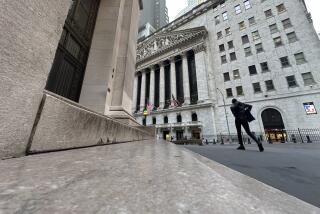Here We Go Again: Stocks Slide, Recover
The stock market on Wednesday went on one of its most dizzying rides yet this year, plunging in the morning then recovering most of the losses by day’s end.
Despite the sharp rebound, however, analysts said there were few strong clues to suggest that prices have bottomed.
At its low point 20 minutes into the trading day, the Dow Jones industrial average had fallen a chilling 435 points, or 4.3%, and the Nasdaq composite was down as much as 5.8%.
But share prices then rocketed through the morning, and leveled off for the rest of the day. At the end of trading the Dow was off 114.69 points, or 1.1%, at 9,975.02--its first close below 10,000 since mid-March.
Nasdaq ended down 42.40 points, or 1.3%, at 3,171.56. The index, which peaked at 5,048 in March, came within 26 points of slipping below 3,000 on Wednesday morning.
The market, hammered in recent weeks by fears of weakening corporate earnings, was dragged early in the day in part by IBM, which tumbled after its earnings report on Tuesday.
Investors also were spooked by the government’s report of an unexpected jump in consumer prices in September, which raised fears that higher energy prices are fueling price hikes in other goods.
But bargain hunters flocked to the market about half an hour after the opening, with many stocks far below Tuesday’s closing levels.
Shares of banking giant Chase Manhattan, which reported earnings early Wednesday, fell to $32.38 early in the day, but ended at $36.88, down $1.06.
IBM, too, recouped some of its slide. The shares fell to $90.25 at their low, and closed at $95.44, down $17.56, or 15.5%.
Trading volume overall was very heavy: More than 2.5 billion shares changed hands on Nasdaq and more than 1.4 billion traded on the New York Stock Exchange.
Even with the rebound, falling stocks outnumbered winners by 25 to 14 on Nasdaq and by just shy of 2 to 1 on the NYSE.
Wednesday’s losses left the Dow down 11.2% since Sept. 1. Nasdaq is down 25% in the same period.
Many past market downturns have ended on heavy volume days in which a final wave of sellers hits the market. In many cases, such trading days were marked by a flood of selling in the morning that gave way to a sharp rebound in the afternoon.
Despite the enormous trading volume on several days recently, however, some analysts said that Wednesday didn’t have the feel of such a final “capitulation” day.
“Even though there are some signs of capitulation, I don’t know that you’re seeing any real signs” that sellers are exhausting themselves, said William Raftery, technical analyst at Salomon Smith Barney in New York.
Still, some of the ingredients necessary for a bottom, such as increasing bearish sentiment among investors, are in place, experts say. The Chicago Board Options Exchange put/call ratio, for example, closed Wednesday at its most bearish level of the year, at 1.01.
That means investors were buying slightly more puts than calls. Puts are option contracts giving investors the right to sell stock at specified prices in the future. Heavy put buying means investors are trying to protect themselves from a deeper market decline.
After rebounding dramatically last Friday from heavy selling earlier that week, the market has been unable to produce a so-called follow-through day in which a second wave of buyers emerges.
“There are still a lot of uncertainties out there--particularly in the Middle East--that could throw this market off-balance,” and investors are reluctant to jump in until they are convinced that the path is clear, said Ed Nicoski, analyst at U.S. Bancorp Piper Jaffray.
What’s more, yields on corporate bonds--especially high-yield junk issues--continue to soar amid growing concerns about companies’ financial health. A key index of junk yields rose Wednesday to 11.81%, its highest since 1992.
Even so, some pros say they’re telling clients to move into favored stock sectors now, rather than try to call the ultimate bottom.
Raftery, for example, is recommending select stocks in the energy, electric utility, phone and consumer-staples sectors.
Said Alan Skrainka, chief market strategist at brokerage Edward Jones in St. Louis: “We don’t have high expectations for [PC-related stocks] Dell, Intel and Microsoft in the short-term, but investors should use this opportunity to build positions for the long-term.”
Those beaten-down shares were among the winners on Wednesday. Dell gained $1.88 to $26.25, Intel jumped $2 to $38.19 in the wake of its profit report Tuesday, and Microsoft added $1.31 to $51.75, then surged to nearly $55 in after-hours trading after the firm sounded upbeat in its profit report.
Other depressed tech shares rebounding included America Online, up $3.31 to $46.91; WorldCom, up $2.13 to $23.94; and Novellus Systems, up $2.88 to $34.56.
But Cisco Systems fell $2.31 to $52.25, Nortel Networks sank $4.19 to $59.81 and Applied Materials slid $2.44 to $42.06.
Among blue chips, gainers on Wednesday included Procter & Gamble, up $2.75 to $74.69; Philip Morris, up $1.31 to $33; and Home Depot, up $1.38 to $36.50.
Market Roundup: C11, C12
More to Read
Inside the business of entertainment
The Wide Shot brings you news, analysis and insights on everything from streaming wars to production — and what it all means for the future.
You may occasionally receive promotional content from the Los Angeles Times.










